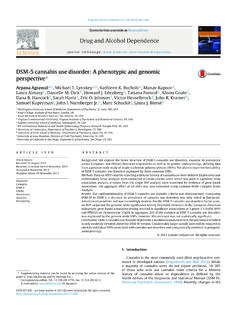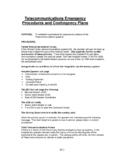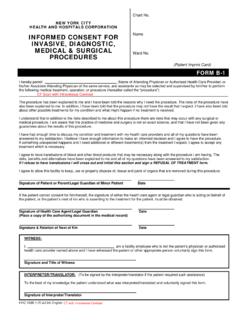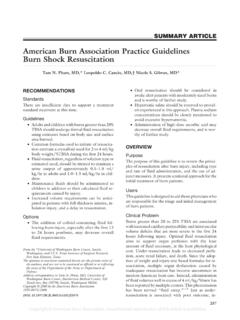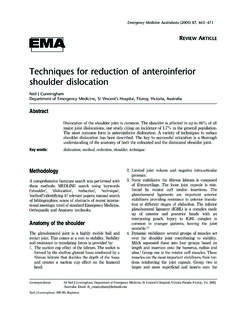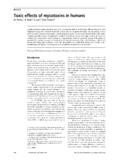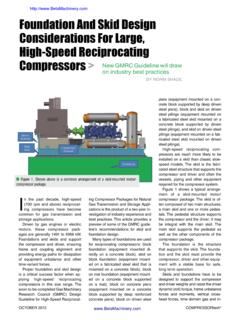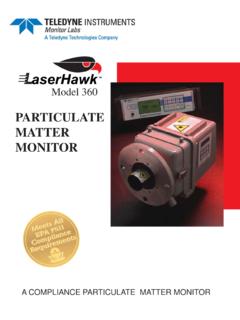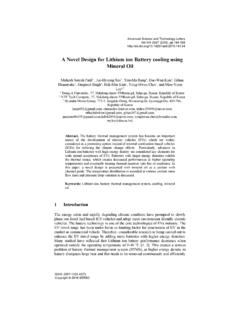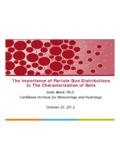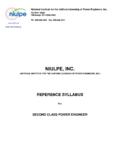Transcription of EEG coherence: topography and frequency structure
1 Exp Brain Res (2009) 198:59 83. DOI RESEARCH ARTICLE. EEG coherence : topography and frequency structure David Balin Chorlian Madhavi Rangaswamy . Bernice Porjesz Received: 6 August 2008 / Accepted: 29 June 2009 / Published online: 22 July 2009. Springer-Verlag 2009. Abstract Topographical patterns of bipolar EEG coher- Introduction ence are frequency specific, indicating the presence of diverse neuroanatomical and neurophysiological factors in Functional connectivity between different regions of the EEG production. Bipolar EEG coherence values were brain in the resting state has been a recent topic of interest calculated at 50 frequency bins ranging from 3 to 28 Hz for in neurophysiological research.
2 Patterns of resting-state 39 coherence pairs. Data were derived from min of activity are important for understanding intrinsic neural resting EEG obtained from 106 healthy adult male subjects function, and may be significant in shaping responses to and analyzed in Hz bins by Fourier transform methods. stimuli (Hanslmayr et al. 2007; Fox et al. 2007; Raichle frequency bands were clearly separated at and 13 Hz, and Gusnard 2005). Studies with fMRI show default- with a less distinct separations at 6 and 20 Hz. Within pair mode'' networks: regions which show common temporal (non-topographic) and across pair (topographic), measures patterns of hemodynamic activity in the resting state and gave similar patterns of separation.
3 Significant pathways whose activity may be attenuated in task situations were primarily anterior posterior interhemispheric or per- (Raichle and Snyder 2007; Fox and Raichle 2007; Mantini pendicular to the anterior posterior axis. There was little et al. 2007; Salvador et al. 2005). An additional perspec- difference between left and right for comparable pairs. tive on resting-state activity is offered by the study of Theta band coherent activity involves distinct midline and connectivity using measures of EEG coherence . Connec- temporal sources, with temporal sources showing anterior/ tivity is established in fMRI studies by the correlations in posterior differentiation.
4 In contrast, alpha activity has a hemodynamic activity over time between different brain distinct posterior focus, while beta activity shows no clear regions. An analogous pattern in an EEG study would be global structure . A spatially homogeneous model based on correlations in amplitude over time between different scalp characteristics of thalamocortical connectivity accounts for locations within particular frequency ranges. We consider much of the data, but departures from the model indicate coherence measures of consistency in phase relations the contribution of other neural factors to coherence .
5 Between pairs of locations over time a more sensitive measure of connectivity than correlations in amplitude, Keywords coherence Bipolar topography since communication between two groups of neurons is a EEG function of the pattern of their oscillatory behavior (Fries 2005; Buzski and Draguhn 2004). Since connectivity pat- terns and neural function may be specific to the frequency This work was supported by NIAAA Grants AA002686, AA005524, of neural activity (von Stein and Sarnthein 2000), a par- and AA008401 at SUNY Downstate Medical Center. ticular advantage of EEG coherence measures is the ability to assess topographic relations as a function of frequency .
6 D. B. Chorlian (&) M. Rangaswamy B. Porjesz Although EEG coherence measures cannot provide the Henri Begleiter Neurodynamics Laboratory, anatomical specificity attainable by the use of fMRI, the Department of Psychiatry, SUNY Downstate Medical Center, 450 Clarkson Ave., Brooklyn, NY, USA high degree of frequential specificity provides a useful e-mail: complement to those results. If coherent activity is 123. 60 Exp Brain Res (2009) 198:59 83. necessary for functional neural communication, and if theoretical coherence values are a relatively simple func- functional activation changes hemodynamic activity, then tion of the distance between the coherence pairs (we note examination of EEG coherence measures may be particu- that the mechanism in the dispersive model is unrelated to larly useful in interpreting the functional aspect of con- volume conduction).
7 Nectivity. We suggest, based on the results presented here, Robinson's (2003) initial paper attributes coherence to that specific resting-state networks (RSN)/connections a single spatially homogeneous neurophysiological found in fMRI studies may be associated with neural mechanism. [Subsequent papers allow for spatial non- activity with distinct coherence spectra. uniformity: O'Connor and Robinson (2004), Robinson coherence is a linear synchronization measure between (2005). Ursino and Zavaglia (2007) and Zavaglia et al. two signals recorded at different locations. It is a statistical (2008) provide models with multiple interacting fre- measure of the average agreement in phase difference, quency mechanisms.]
8 ] Although it is unlikely that all weighted by amplitude, between two signals measured over coherent EEG activity can be attributed to a spatially time, and is frequency specific. coherence values range homogeneous and isotropic single dispersive mechanism, from 0 to 1, with 1 meaning perfect agreement in phase Robinson's theory provides a useful starting point for the difference and 0 meaning completely random phase dif- investigation of coherence , since it accounts for the main ferences. A signal recorded at a single electrode is a features of the observed coherence spectra (see Fig.)
9 1). function not only of the neural activity directly beneath it, with more fidelity than other models. We may identify but also of neural activity at more distant locations prop- patterns which are not solely a function of simple dis- agated by electromagnetic fields as mediated by the inter- persion by applying Robinson's theory to the coherence vening tissue and other matter. This latter phenomenon is data to identify and eliminate the effects of that dispersion called volume conduction. Volume conduction effects can on coherence values. contribute strongly to coherence measures of raw'' sig- In the present study, we examine and describe in detail nals, inflating their values and reducing their topographic the topography and frequency structure of EEG coherence variability.
10 A number of different data transformations in the resting state. We distinguish three modes of char- (data preprocessing methods), if performed before the acterizing topography . The primary topographic feature is coherence calculation, can reduce volume conduction the pattern of connectivity determined by the magnitude of effects. The Laplacian (or current source density) provides the coherence values between different locations. In that a reference-independent transformation which eliminates case, topography is characterized in terms of the orienta- most volume conduction effects. Signals transformed to tion and location of the lines connecting one location with bipolar form by subtractions between adjacent electrodes, another.

